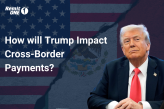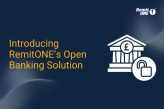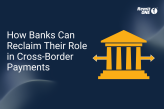Video: Cryptocurrency as a Payment Method – The new growth potential for money service businesses June 28, 2022

In our latest IPR Webinar, our expert partners from BP Ventures LLC joined RemitONE to explore the use of Cryptocurrency as a payment method in the money transfer industry, and how using the USDC can benefit money service businesses as they shift to a more digital way of transacting.
Webinar moderator:
- Aamer Abedi, CMO, RemitONE
Panellists:
- Jeffrey Phaneuf, Director, BP Ventures LLC
- Anthony Barker, Director, BP Ventures LLC
- Arif Saleem, CTO, RemitONE
Time Stamps
00:00 Introductions
14:24 What is the next big thing in the ecosystem for remittances?
17:29 How have you seen payment methods change over the years?
19:37 What is USDC? How does it compare to other USD-denominated stable coins?
23:29 Why use the USDC stable coin as a payment mechanism?
28:27 What is the fear that MTOs may have using USDC? How do we address this?
31:31 How can we address the bank account issue?
34:45 What are the benefits of using USDC as a payment mechanism for the individual users?
37:54 What’s different from paying with a stable coin instead of traditional methods?
40:19 What is the cost to the MTOs?
43:10 How do we take advantage of the Moneygram USDC opportunity?
44:03 Risk profile of USDC vs. cash or card?
44:56 How can USDC as a payment mechanism decrease Chargeback rates & Fraud?
45:47 Margins are compressing for MSB’s, how does using USDC help increase revenues?
47:14 Are users going to use stable coins & can we settle it?
53:05 Next steps, how can we implement USDC as a payment mechanism leveraging RemitONE?
59:48 What procedures and policies need to be in place to enable USDC?
Please let us define the terms blockchain cryptocurrency stable coin and token.
Anthony: So, Blockchain is a word that you’ve probably heard in the news everywhere. It comes from Bitcoin which has a technological system where that verifies blocks of transactions (the blocks come every 10 minutes) and computers all over the world. Right now, in Bitcoin, there are over 5000 computers, called validators, that validate the transactions.
An example of a cryptocurrency is Bitcoin. Cryptocurrencies typically use blockchains. So, the ones you might have heard of might be Ripple, Stellar, Bitcoin and Ethereum. The difference between a stable coin and a token is that a stable coin is typically tied to the value of a currency. So, the one we’re talking about today is called USDC.
USDC is a stable coin issued by Circle Corporation, which is a US-regulated financial institution. It’s audited by third-party auditors. So, these are stable coins, they’re tied one to one. And in theory, you should be able to cash out $1 of USC for one US dollar.
Why Stellar? What, in your opinion, distinguishes Stellar from other blockchains?
Anthony: Stellar and Ripple would have been built up, really to focus on the international cross-border payments. At that point, Ripple was closed source; it was owned by one corporation and was really focused on promoting its XRP token, which was issued mostly to employees, founders and investors in Ripple. Then I compared it to stellar, all of the software was open-source from the beginning, and that seemed to me to be a better platform to build on where you can add additional value.
The volatility in the cryptocurrency markets, as evidenced by the fluctuating Bitcoin value graphs, can make a money service business, which obviously wants prices to be as stable as possible, extremely nervous. How does cryptocurrency as a payment method solution, that BP Ventures and RemitONE are proposing here, address this concern of volatility?
Anthony: Bitcoin and Ethereum are mostly used on these offshore contract-for-difference trading platforms, which are highly leveraged. So people are individual traders are trading at it at a 10 to one ratio or a 100 to one ratio, so you can have 100 bitcoins controlled with your one Bitcoin. So when the market collapses it has a tendency of going up very quickly and down very quickly now. But stable coins, because they’re tied to the US dollar or Euros, they are much better for remittance companies.
If you look at the bailouts that occurred in 2008, when major companies like Barclays and other major institutions went bankrupt, they had to have government intervention to save the whole ecosystem. If you look at cryptocurrency, to give them some benefit of the doubt, it’s still running. There are still transactions clearing, there’s still settlement, and the USSC dollar is still worth $1. So it is growing, and its funds are based on US Treasuries. So they’re not sitting their money in some risky offshore thing. All of their funds are in short-termed US Treasuries. So USDC is safe. With other Cryptos, there are different levels of risk.
What is the next big thing in the ecosystem for remittances?
Jeffrey: I think given the recent announcement of Moneygram’s cooperation with Stellar to offer USDC the cash in cash out, we believe that digital crypto blockchain powered payments is potentially the next big thing in the ecosystem. We’ve been involved in Stellar blockchain for a number of years. I think the fact that MoneyGram has confirmed their entry into this space, certainly confirms that using USDC as a payment mechanism on Stellar blockchain has some merits.
Arif: One of the big problems in remittances is the friction at different levels when you’re talking about international transfers. And any new technology, that can reduce that friction and reduce the cost associated with that friction, is definitely going to become more important as time goes along, especially if regulatory and other concerns can be addressed and delayed. So in that sense, it does appear as though one-to-one-backed stable coins offer a very friction-free international transfer.
USDC – what is it and how does it compare to other US-denominated stable coins like USDT and even CBDCs that aren’t mentioned?
Anthony: There are two main issuers in the United States as regulated institutions, one’s called Paxful, and the other one is called Circle. Its price equals one dollar. It hasn’t really fluctuated from that, in the past four years. It’s managed by something called the Circle Consortium, which is a group of companies that oversee the financial standards for stable coins and ensure there’s transparency around the one-to-one backing. That means for one USDC created there’s $1 held in reserves typically in a bank, or in US Treasuries. Now, USDC is available on multiple blockchains. And this is where it gets a little bit confusing for remittance companies. So there’s multiple blockchains around that are all competing, they’re vying to get adoption by users.
Why should the MSBs the money service businesses use the USDC stable coin as a payment mechanism?
Jeffrey: We believe that there are several compelling reasons why USDC as a payment mechanism is interesting for MSBs. One is that it’s fast, meaning that funds are received within 3 to 5 seconds, versus a payment that you would receive, let’s say, by a card processor that sends us the funds up to 15 seconds after the transaction was performed on the long side. So that’s one reason why we’re advocating USDC as a payment mechanism.
The second reason is that we think it’s better regarding decreasing both fraud and chargebacks. USDC payments are irreversible. And so again, my experience and depending on the MSB, we had significant chargebacks, we had fraud related to customers that would come back and were requesting a chargeback, which ultimately, and in some cases meant that we were out of the money at the end of the day. So this is where the USDC payment as a payment mechanism avoids this.
What are some of the fears the MTOs have the MSBs have about using USDC? And how do we address these fears?
Jeffrey: I think there are probably two particular items that obviously that come to mind. One is regulatory concerns when using cryptocurrency or stable coins. And that basically would be contingent on what jurisdiction the MSB is in and do they require any specific or additional licensing. The second item I would say is in the banking sphere. And MSBs normally are always susceptible to banking relations just in normal times. So certainly, bank relations are precious and MSBs may fear an impact if they offer USDC as a payment mechanism.
From an MSB perspective, as long as they meet the regulatory criteria, all they have to do is sign up with an entity like Circle to gain access to USDC and have this BP Ventures payment gateway enabled for their end-users?
Jeffrey: That’s right. To be able to assist those that have issues getting a USD Circle account, BP Ventures can assist at that stage. But for larger MSBs, yes, we would certainly recommend that they would just open the USD Circle accounts. And the fact that we’re going to have this integration directly into RemitONE means that there’s no setup fee, they’re off and running. And it should be really a compelling new payment mechanism to be able to offer MSBs customers.
What’s different from paying with a stable coin versus these traditional methods today?
Arif: So essentially, the payment process remains the same for the end-user. So, the same flow would happen, when using the BP Ventures gateway for collecting the USDC, it’s just that instead of providing your card details, you would instead be providing the wallet numbers from which the funds would be paid and the wallet to whom the funds are going to go. So, in that sense, the payment process is very similar, there’s not really a great deal of difference in terms of flexibility. One of the things about USDC tokens is that you don’t have to be in the US to use them. You don’t have to have a USD account to use USDC tokens – you could be in any country as long as it’s legal.
And what does using USDC mean, in terms of increasing revenues for our MSBs?
Jeffrey: With USDC, you get the funds immediately, you reduce your charge chargeback and fraud rates, meaning that you’re not at a loss in those areas. So, your revenues basically should go up due to the fact that the fee proposed is either for free or after 10,000. USDC is lower than cards means that your revenues again should go up, because hopefully the transaction is going to be more profitable.
And finally, are users going to use stable coins?
Anthony: So with BP, we have a certain approach that basically we think that an MSB should roll it out step by step. We’re pushing the acceptance of the USDC as the first step for MSBs. The second one is to actually as an MSB sell the USTC. So, customers can come online and actually buy the USDC and you can mark it up. Now the third step that MSBs may do in the future is actually settled with correspondence using USDC. We think that that’s going to happen in the future. We tried it previously, with tempo in the Philippines, we had it working to the Philippines, Nigeria, and Brazil. That worked. It’s just not quite there at the critical mass yet. So that’s why we’re really recommending it as a risk-based approach.
Jeffrey: We think there are a lot of compelling reasons to try it. And we’re going to try to make it from a technical side, as easy as possible as seamless as possible to incentivize people to use it, and to make the financial reason to use it as well, a compelling reason. So, we’re optimistic that it is a very viable way to make a payment.
For more information or to request a free consultation with one of our money transfer specialists, please email marketing@remitone.com
What next?
Now that you’ve read our article we want to help you get the most out of it and plan for 2022.
Tap into our experts and schedule a free consultation.
Related Posts
-

How to Build a Leaner, Smarter Money Service Business in 2025
In an era of rapid regulatory change, rising customer expectations, and digital disruption, how can money service businesses (MSBs)—companies that…
May 22, 2025 -

Trump’s Threats to Cross-Border Payments: What It Means for Your Business
It’s been a short while since Trump stormed back into office, and he’s already shaken things up with his hard-hitting…
May 22, 2025 -

Unlock Faster, More Secure Payments with RemitONE’s Open Banking Solution
We’re excited to introduce the latest enhancement to our RemitONE Money Transfer Platform: the RemitONE Open Banking Solution. Competitively priced…
January 31, 2025 -

How to Expand Your SEND Operations in the UK and Europe—Without the Regulatory Hassle
The remittance market in Europe is valued at €133.7 billion annually, with the UK market contributing an additional £23 billion.
January 31, 2025 -

The Top 5 Cross-Border Payment Trends That Shaped 2024
What a year it’s been for the world of payments! From breakthroughs in tech to surprising shifts in consumer behaviour,…
December 19, 2024 -

How Banks Can Reclaim Their Role in Cross-Border Payments with RemitONE
Banks, once the cornerstone of international payments, are finding themselves sidelined. Senders and receivers have now joined forces, pushing banks…
December 18, 2024